Christoffel Pierson. Niche with Falcony Gear, ca. 1660-1670 . Washington, National Gallery of Art. Patrons’ Permanent Fund. © National Gallery of Art, Washington
Painting images that are impossible to distinguish from reality has been a challenge for artists of all periods. The ability to deceive the viewer by making the painted seem real through the laws of optics and perspective is a visual game of which the earliest examples are known from descriptions in Greek literary texts. Since then, trompe l’oeil has been extensively present in the arts, particularly flourishing in periods such as the Renaissance and Baroque, after which it declined with Romanticism but never disappeared from the artistic repertoire.
Samuel van Hoogstraten Trompe l'Oeil Still Life, 1666-1678 Oil on canvas. 63 x 79 cm. © Karlsruhe, Staatliche Kunsthalle The exhibition Hyperreal. The Art of Trompe l’Oeil, organised with the collaboration of the Comunidad de Madrid, offers a reassessment of the genre through more than 100 works of high quality loaned from museums and private collections around the world which exemplify the themes most widely encountered in easel paintings of this type. The chronological span encompasses the 15th to 21st centuries but the works are presented in terms of content and compositional format rather than by date of execution in order to emphasise the continuity of the genre, which is still in use today.
The exhibition is structured into the following sections: Mise-en-scène, devoted to the still life; Figures, frames and boundaries, which looks at the visual deception of the painted frame; Alcoves for the inquisitive, with depictions of niches, windows and cupboards housing objects that deceive the viewer’s eye; Fake walls: Planks and Partitions, transformed into settings to display objects that reveal the artist’s skill; Perfect disorder and corners of artists’ studios, which focuses on artists’ working spaces and on so-called quodlibets, a sub-genre of the trompe l’oeil; Appeal to the senses, featuring compositions with sculptures or flowers as the principal motif; American renewal and its wake, devoted to various American artists who rethought this genre and their influence, and The modern trompe l’oeil, featuring works notable for revealing their creators’ imagination and ability to surprise, with a particular focus on the 20th and 21st centuries. The exhibition concludes with a work by the sculptor Isidro Blasco that has been specially commissioned as the conclusion to this survey. 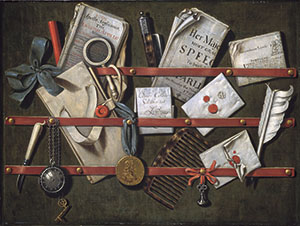
Edwaert Collier. Trompe l'Oeil, ca. 1703. Leiiden, Museum De Lakenha.The exhibition Hyperreal. The Art of Trompe l’Oeil, organised with the collaboration of the Comunidad de Madrid, offers a reassessment of the genre through more than 100 works of high quality loaned from museums and private collections around the world which exemplify the themes most widely encountered in easel paintings of this type. The chronological span encompasses the 15th to 21st centuries but the works are presented in terms of content and compositional format rather than by date of execution in order to emphasise the continuity of the genre, which is still in use today. The exhibition is structured into the following sections: Mise-en-scène, devoted to the still life; Figures, frames and boundaries, which looks at the visual deception of the painted frame; Alcoves for the inquisitive, with depictions of niches, windows and cupboards housing objects that deceive the viewer’s eye; Fake walls: Planks and Partitions, transformed into settings to display objects that reveal the artist’s skill; Perfect disorderand corners of artists’ studios, which focuses on artists’ working spaces and on so-called quodlibets, a sub-genre of the trompe l’oeil; Appeal to the senses, featuring compositions with sculptures or flowers as the principal motif; American renewal and its wake, devoted to various American artists who rethought this genre and their influence, and The modern trompe l’oeil, featuring works notable for revealing their creators’ imagination and ability to surprise, with a particular focus on the 20th and 21st centuries. The exhibition concludes with a work by the sculptor Isidro Blasco that has been specially commissionedas the conclusion to this survey. 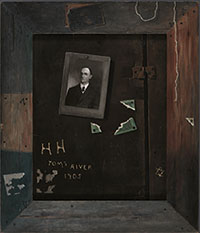
John Frederick Peto. Toms River, 1905. Madrid, Museo Nacional Thyssen-Bornemisza.The term trompe l’oeil (a visual trick or illusion that deceives the viewer by making them think they see something other than what is there) is a French term which first appeared in a dictionary of the fine arts in 1806 although it had already been used as the title for a painting in 1800. The earliest examples date to classical Greece and Rome in the form of mosaics and murals, and literary texts of that period include numerous references to the art of illusion and to artists’ abilities to reproduce nature. The most famous of these texts is the episode narrated by Pliny in which the painters Zeuxis and Parrhasius participated in a type of contest of skills. The realism of the grapes painted by the former was so great that the birds flew down to eat them, while the latter painted a work with a curtain; Zeuxis asked him to draw it back so that he could see the painting, then realised that he had fallen into the trap and so acknowledged his rival’s great skill. This story became very popular during the Renaissance and numerous artists set out to emulate it and create works that produced this effect of a fictive reality through a wide range of pictorial devices and techniques. Together with a skilled use of perspective, foreshortening and effects of light, painters made use of numerous different visual games, such as elements that project out of the painting and invade the viewer’s space, insects which have seemingly settled on the canvas, and materials and textures reproduced in such detail that they deceive and fascinate the spectator. 1. Mises-en-scène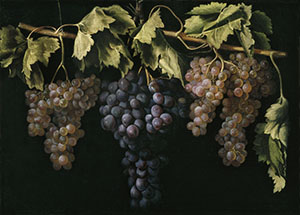
Juan Fernández “el Labrador”. Still Life with four Bunches of Grapes,ca. 1636. Madrid, Museo Nacional del PradoThe still life is the genre that has provided artists with the most opportunities to engage with the myth of illusion through attempts to portray objects, flowers, fruit and other foods in a manner so realistic that it is difficult to distinguish truth from fiction. The exhibition opens with a fragment of a Roman mosaic depicting three partridges, shown alongside notable 16th- to 20th-century examples. They include Antonio Leonelli’s Still Life with Grapes and a Bird(ca. 1525), one of the first surviving examples of still life as an independent genre and a work that reproduces Zeuxis’s composition, including the bird pecking at the grapes. Also emulating the classical painter is the magnificent Still Life with four Bunches of Grapes(ca. 1636) by Juan Fernández “El Labrador”, which employs a degree of naturalism that is also to be found centuries later in works such as Red Bream(ca. 1800) by Bartolomé Montalvo, and Still Life with Quinces(1989) by Isabel Quintanilla. In mid-17th-century Holland trompe l’oeil attained the category of an independent genre, distinct from other types of still life, and its range of themes expanded. We now encounter table or “banquet” still lifes such as those by Willem Claesz. Heda and hunting trompe l’oeils such as the ones on display here by Jan Baptist Weenix and Jean Démontreuil. 2. Figures, frames and boundariesPlaying with the margins, edges or frames of paintings is one of the most frequently encountered devices. During the Renaissance, Flemish and Italian painters began to produce a new type of portrait in which the figure turns to look at the viewer from behind a ledge or through a window opening. In order to confuse illusion and reality, the figure is depicted life-size and the architectural elements are painted in great detail with all their cracks, peeling plaster and other defects, imitating wood or stone to perfection and locating various objects or limbs so that they seem to extend beyond the frame, thus making the boundary between the pictorial space and the viewer’s less clear. This device is to be seen in Andrea Mantegna’s St Mark the Evangelist(1451) and Portrait of a Man with a Ringby Francesco del Cossa (ca. 1472-77). 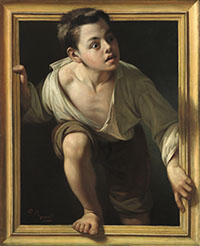
Pere Borrell del Caso. Escaping Criticism (A Thing That Cannot Be, or Boy Climbing Ouy of the Frame), 1874. Madrid, Colección Banco de España.Two fascinating examples of how a painter has played with a fictive frame are Trompe l’Oeil with Self Portrait(ca. 1868) by Jean-Marie Faverjon, and Escaping Criticism(1874) by Pere Borrell del Caso, in which the young man seems to be escaping from the canvas itself. In Holland the 17th century was considered the golden age of trompe l’oeil. This was a time of enormous interest in theories of optics and perspective and artists applied their knowledge to producing the visual games so appreciated by collectors. The second half of the century saw the introduction of a new element: the illusionistic curtain with an interior, a portrait, a still life or a religious scene behind it. This device draws the viewer’s attention to one part of the painting while simultaneously concealing the other, creating a disturbing effect between what can be seen and what cannot be seen but can be imagined. Examples include Man smoking a Pipe(ca. 1650) by Gerrit Dou, and The Rest on the Flight into Egypt(1647) by Adriaen van Gaesbeeck. 3. Alcoves for the inquisitive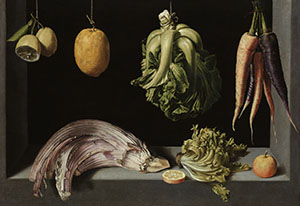
Juan Sánchez Cotán. Still Life with Fruits and Vegetables, ca. 1602. Colección Abelló.A compositional format typical of the trompe l’oeil is the presentation of objects and foodstuffs in niches or with window surrounds. The inclusion of such framing allowed some of these elements to be projected towards the exterior, thus increasing the sensation of reality. It can be seen in the magnificent Still Life with Fruit and Vegetables(ca. 1602) by Juan Sánchez Cotán, and in Smoking Still Life in a Niche(ca. 1635) by Georg Flegel. Other notable works in this section are Niche with Falconry Gear(ca. 1660-70) by Christoffel Pierson and Silverware in an Open Cabinet(17th century) by Cornelius Norbertus Gijsbrechts. Shelves and cupboards housing books and a range of other objects are another of the most popular motifs. Optical effects such as reflections on metal or glass of the objects located in front of those surfaces, a half-open door that steers the viewer’s gaze towards the interior, or keys hanging from a lock and casting their shadow - as in Still Life with Bottles and Books(ca. 1525) by an anonymous German artist and Cupboard with Objects(ca. 1730) by the Sevillian painter Bernardo Lorente Germán - are devices frequently employed by painters to heighten the visual deception. This section also includes the pictorial type known as “Curiosity cabinets”, in which artists depicted the most splendid, curious and evocative items belonging to elite collectors, thus revealing the personalities and tastes of their owners. Examples include the work by Johann Georg Hinz (1666) and others in which books are the only elements, for example Two Shelves with Music Books(ca. 1720-30) by Giuseppe Maria Crespi and The Bookcase(1951) by Kenneth Davies. 4. Planks and walls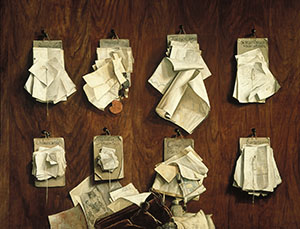
Cornelis Brisé. Documents of the Treasury Wall of the Amsterdam City Hall , 1656. Amsterdam Museum, long-term loan at Royal Palace of Amsterdam.Paper in all its multiple forms - documents, letters, drawings, prints, maps and musical scores - occupies a special place in trompe l’oeil depictions. These manuscripts and prints in all their variety are shown hung on and decorating wooden backgrounds or plaster walls to which they are attached by various means. They allowed artists to demonstrate their skills in reproducing the different techniques of printmaking and calligraphic styles as well as surfaces and textures, with a particular interest in the depiction of folds, tears and numerous other details and imperfections. Documents on the Treasury Wall of the Amsterdam City Hall(1656) by the Dutch artist Cornelis Brisé is a magnificent example, as are Trompe l’oeil(1667-73) by the Andalusian painter Marcos Fernández Correa and Quodlibet with Portraits of Contemporaries and Antique Heads(1757) by the Swiss artist Johan Caspar Füssli, which includes a bee and a wasp that have landed on two of the portraits hanging on the wall. A more modern version is Amiens Cathedral(1919) by Yuri Annenkov; an assemblage that combines collage, wood, cardboard and wire on paper and which evokes traditional trompe l’oeil paintings. This section also includes a group of works in which the objects hanging from a wall are associated with hunting, including weapons, trophies, equipment and accessories. In Still Life with Hunting Equipment(1665) Johannes Leemans emphasises the sense of illusion by allowing the butt of a gun and other objects to intrude into the frame, while in Trompe l’Oeil with Arms, Hunting Equipment and a Clock(ca. 1690) by the Valencian Vicente Victoria the notable technical skill in the reproduction of the objects, the study of the shadows falling on the background and the presence of an insect on the wall all serve to emphasise the illusory effect. 5. Perfect disorder and corners of artists’ studios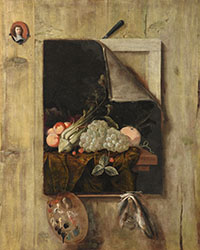
Cornelius Norbertus Gijsbrechts. Trompe l'Oeil Still Life, 1663. Carcassonne, Collection Musée des Beaux-ArtsQuodlibets (from the Latin quod and libet, “what pleases” or “whatever you wish”) are a subsection of the genre and are also known as “letter-racks”. They depict a wide range of everyday objects or items belonging to the artist or the person who commissioned the work (papers, letters, prints, small items of jewellery, letter openers, hair combs), seemingly arranged at random on a flat surface and held in place by ribbons or cords that are fastened to form lines or grids. They were first devised in 17th-century Holland and the painters Cornelius Norbertus Gijsbrechts and Samuel van Hoogstraten were their most important exponents. In these works, the apparently unrelated painted objects acquire significance through their inclusion and combination, whether as a commission in which they thus reflect the client’s tastes or possessions, or through the artist including his own possessions in order to uphold his profession and demonstrate his skill. In both cases such works have become outstanding records of their time. This section also features corners of artists’ studios, which are depictions of objects relating to a painter’s activity, in some cases shown alongside works by the artist. They can be interpreted as a type of self-portrait or self-promotion. Trompe l’Oeil Still Life(1663) by Gijsbrechts, which depicts a canvas of a still life partly detached from its stretcher and a selection of the artist’s working tools is an exceptional example, as is Trompe l’oeil(ca. 1670) by Gijsbrechts’s follower Jean-François de Le Motte, which includes a reproduction of a marine view alongside various objects such as a letter with the artist’s name and address on it. The Immodest Mona Lisa(1986) by Pierre Gilou demonstrates the survival of this genre in the 20th century, in this case in the form of a shelf with artist’s pots and brushes beneath the unfinished canvas of the Mona Lisawhich is partly concealed by a curtain in a knowing reference to the legend of Parrhasius. 6. Appeal to the senses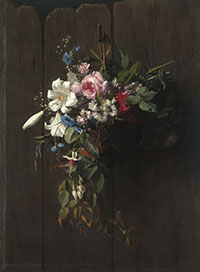
Clara von Sivers. Flowers, 1877. Chemnitz, KunstsammlungenLa Grisaille was the technique most widely used by painters to imitate sculptures and reliefs. The celebrated Annunciation Diptych(ca. 1433-35) by Jan van Eyck in the Thyssen collection shows the artist’s skill in the reproduction of different materials, from the alabaster of the sculpted figures to the marbles and stones of the fictive frames and the mouldings. Jacob de Witt’s Vestal Virgins(1749), which simulates a low relief in a niche, was part of an overmantel decoration. The fashion for decorating private houses with monochrome paintings imitating classical reliefs was particularly favoured in France in the late 17th and early 18th centuries. Trompe l’oeil(1771) by Jean-Étienne Liotard is another fine example of the art of painting sculptures, depicting two small reliefs and two drawings hung from a board with a masterly imitation of its grain and of the use of fictive shadows to increase the sense of reality. Another leading specialist in reproducing sculptures and reliefs in painting was the Swiss artist François Ferrière, represented here by two canvases, Music and Poetry (prior to 1821), which metal low reliefs in metal with simulated carved wooden frames. A delicate feather in the first work and a beetle in the second increase the illusionistic effect. Flowers are another of the most widely used motifs in trompe l’oeil painting, either arranged in the form of bouquets, baskets, vases and garlands or as a complement to other subjects. One of the specialists in this field was Daniel Seghers whose habitual format, a garland framing the central subject, was adopted by other artists such as Johann Rudolf Bys in Flower Still Life: Cartouche with Garland, inside a View of a Seaport(ca. 1713), a work that reveals a careful depiction of the play of light and shadow and the presence of small insects on the flowers and the window surround. Moving into the 19th century, a notable figure is the flower and still life painter Clara von Sivers whose work Flowers(1877) depicts a colourful bouquet suspended from an angled nail against dark panels depicted to show their grain and imperfections. 7. American renewal and its wake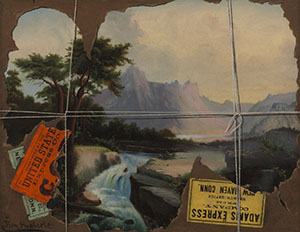
John Haberle. Torn in Transit, ca. 1890-1895. Chadds Ford, Brandywine River Museum of Art. Donated by Amanda K. BerlsThe works in this section demonstrate the importance of trompe l’oeil in the United States in the 19th and early 20th centuries at a time when the genre had already declined in Europe, revealing a wide variety of styles and compositions. Some are filled with painted objects while others are notable for their compositional simplicity. All, however, share the ability to attract the viewer’s attention, inviting us to explore their details and illusionism.
Artists such as Harnett, Haberle, Peto and Cope turned to objects from the world around them (documents, smoker’s implements, hunting trophies, musical instruments, banknotes, newspaper and letters) which they used to evoke memories or past events, in some cases as a way to exalt the collective national memory and in others to refer to current-day issues such as the economy, consumer culture or censorship, encouraging the viewer to discover the tricks of representation and the meaning hidden in these paintings. Trompe l’oeil was extremely popular in the United States and artists made every effort to ensure that it became an independent genre. This freer form of interpreting it is one of the keys to understanding its evolution in the 20th century, also evident in the work of European artists such as the French painters Pierre Ducordeau, a member of the “Peintres de la réalité” group, and Henri Cadiou who belonged to the “Trompe-l’oeil/Réalité” group founded in the 1960s, as well as the Dutch artist Ton de Laat and the Chilean Claudio Bravo. 8. The modern trompe l’oeil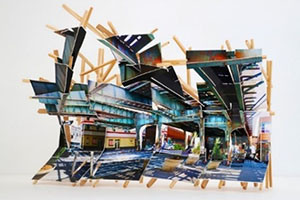
Isidro Blasco. Elevated Train in Brooklyn, 2022. Isidro BlascoThe final section of the exhibition presents a group of works notable for the acuity and ingenuity with which their creators provoke the viewer’s surprise. Some examples date back to the 16th century but the emphasis here is on the 20th and 21st centuries. Particularly original canvases are The Earth(ca. 1570) by the unique Giuseppe Archimboldo, which has numerous figures of animals that fit together perfectly to form a head in profile, and the unusual Henhouse by Jean-François de Le Motte (17th century). They are shown alongside works by Salvador Dalí, such as Maximum Speed of Raphael’s Madonna(ca. 1954) from his “mystical-nuclear” phase in which he fused science and religion, and Antonio López, including Window in the Afternoon(1974-82) which once again plays with interior and exterior space. This room also displays examples of the survival of the genre in art today, includingNets. The fishing Port of Marbellaby the Spanish artist Gerardo Pita (2015-16), two paintings by César Galicia from his Manhattan series and an oil on panel by Manuel Franquelo. Finally, Elevated Train in Brooklyn(2022) is a modern, urban collage that combines photography, sculpture and architecture, specially created for the exhibition by the artist Isidro Blasco. As the final work in this survey, it returns viewers to reality in the sense that without being a trompe l’oeil in the strictest sense, it encourages a reflection on the reality/representation duality characteristic of this genre.
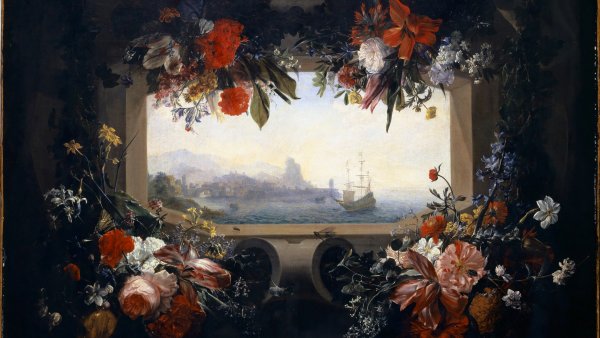
Johann Rudolf Bys
Flower Still Life: Cartouche with Garland, inside a View of a Seaport, ca. 1713
Oil on canvas, 76 x 86 cm. Kunstmuseum, Basel. Schenkung der Prof. J. J. Bachofen-Burckhardt-Stiftung, 2015. Photo: ©Kunstmuseum, Basel

Clara von Sivers
Flowers, 1877
Oil on canvas, 81 x 60 cm. Kunstsammlungen, Chemnitz. Photo: bpk / Kunstsammlungen Chemnitz / May Voigt
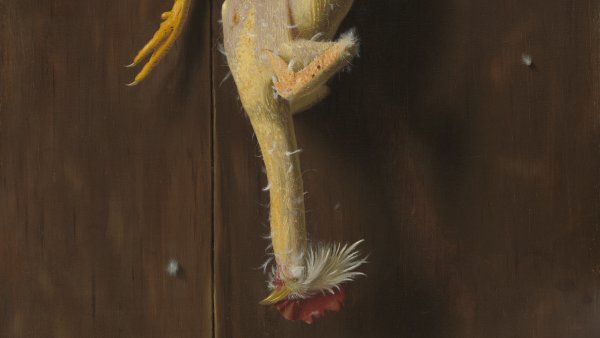
William Michael Harnett
Plucked Clean, 1882
Oil on canvas, 86.8 x 51.7 cm. National Gallery of Art, Washington. Corcoran Collection. Museum Purchase, William A. Clark Fund. Photo: © National Gallery of Art, Washington
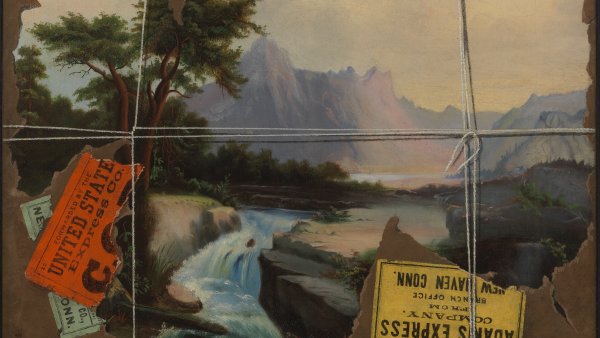
John Haberle
Torn in Transit, ca. 1890-1895
Oil on canvas, 34.3 x 43. 2 cm. Brandywine River Museum of Art, Chadds Ford. Gift of Amanda K. Berls, 1980. Photo: © Brandywine River Museum, Chadds Ford
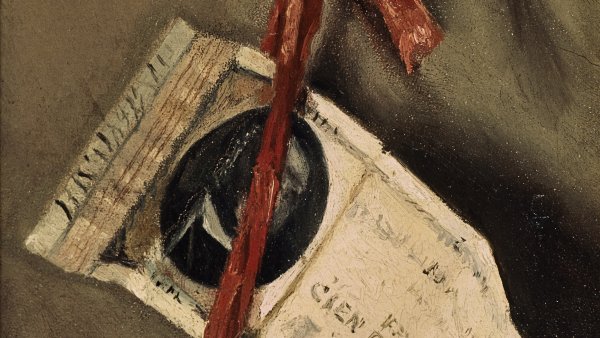
Attributed to Mariano Fortuny y Madrazo
A One-hundred Pesetas Note, ca. 1898
Oil on canvas, 33 x 24 cm. Banco de España Collection, Madrid. Photo: © Colección Banco de España, Madrid
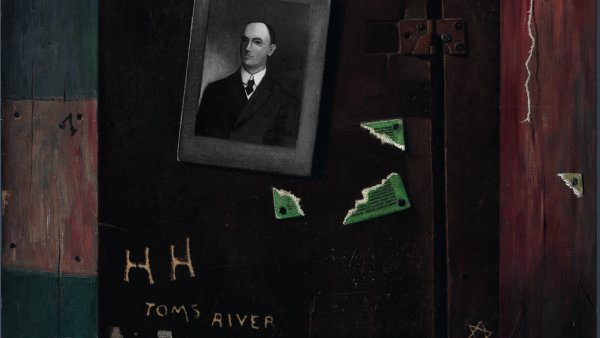
John Frederick Peto
Toms River, 1905
Oil on canvas. 68 x 58.3 cm. Museo Nacional Thyssen-Bornemisza, Madrid
LOW RESOLUTIONHIGH RESOLUTION
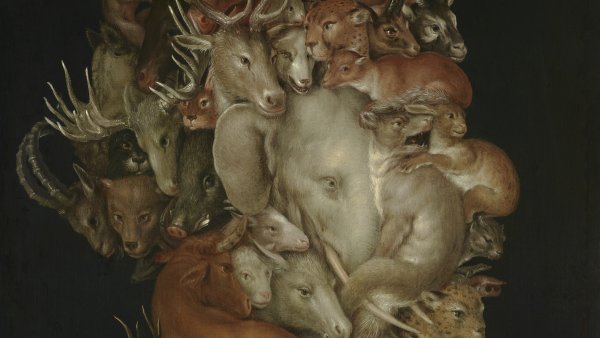
Giuseppe Arcimboldo
The Earth, ca. 1570
Oil on panel, 70 x 49 cm. Vienna-Vaduz, Liechtenstein. The Princely Collections. Photo: “LIECHTENSTEIN. The Princely Collections, Vienna-Vaduz”

Jean-François De Le Motte
Henhouse, 1625-1650
Oil on canvas. 65 x 54 cm. Arras, Musée des Beaux-Arts. Photo: © Musée des Beaux-Arts, Arras. France
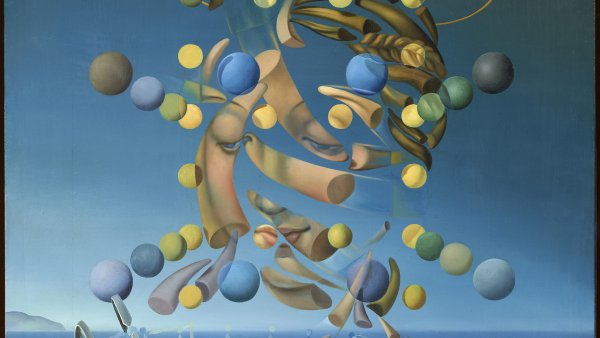
Salvador Dalí
Maximum Speed of Raphael’s Madonna, ca. 1954
Oil on canvas, 81 x 66 cm. Museo Nacional Centro de Arte Reina Sofía, Madrid. Photo: © Museo Nacional Centro de Arte Reina Sofía, Madrid
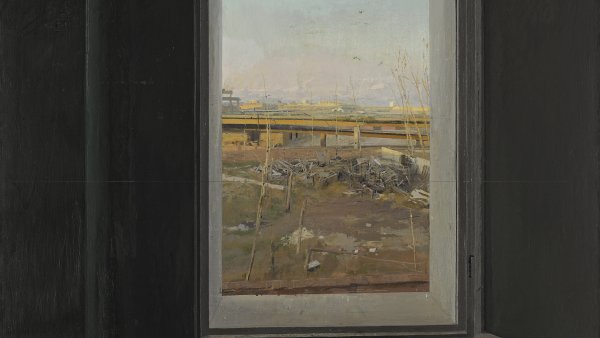
Antonio López
Window in the Afternoon, 1974-1982
Oil on panel, 141 x 124 cm. ACS Collection, Madrid
|
|
|
|